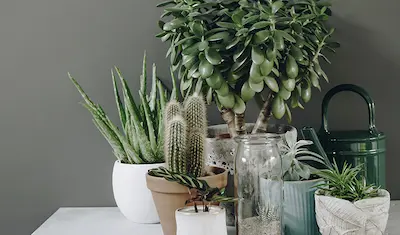How to Care for Indoor Plants

Nothing freshens up your interior living space like indoor plants, and in addition to their beauty, they can also help to enhance the quality of your indoor air. The key to keeping your plants happy and healthy is providing them with the right levels of nutrients, light, and water, but if your plants are looking dreary The Grounds Guys® have some great advice on indoor plant care to get them back on track.
How to Care for Indoor Plants
While all plants have the same basic needs for water, nutrients, soil, and light, these requirements can vary according to each season. Here are some great tips for how to care for indoor plants throughout the year:
Spring
After the winter dormancy period, the days grow longer, temperatures rise, and house plants begin to sprout new growth. This is a great time to repot plants that have outgrown their containers, opting for a new pot that is between one and two inches larger in diameter than the old.
Spring is also a great time to fertilize your plants at about half-strength to give them an extra boost.
Add your plants to your list of spring cleaning projects by gently wiping waxy leaves with a damp cloth or dusting delicate leaves with a soft brush, always supporting the underside of the leaf to prevent breakage. Trim off any yellow leaves and prune long vines that have become leggy.
Summer
Keep an eye on indoor plants during the summer months as they may become scorched if left on a sunny windowsill. Summer is the ideal time for indoor plants that don't do well in the heat and they will appreciate the air-conditioned comfort of your interior.
Summer heat can rob your house plants of moisture, and it's important to check on them every few days to determine if they are dry. Water slowly and deeply as needed for best results, and increase moisture by placing plant pots on a bed of pebbles filled with water, or mist on a regular basis.
Fall
Drastic temperature changes between daytime and evening can take a toll on plants. Bring in plants that were placed outdoors for the summer, checking carefully for pests.
Water your plants less often, but increase the humidity level in your home to compensate for dry, heated air.
Move plants if necessary to ensure they receive adequate lighting on shorter days.
Forgo fertilization until the spring.
Winter
Be prepared to move your plants to another location to meet their lighting needs, and ensure they are away from drafty windows or unheated spaces.
Watch for pests as plants are more susceptible due to a lack of sunlight, increased humidity, and high heat.
Overwatering is common during the winter months and is the easiest way to kill your house plants. Place plant pots in the sink or bathtub and allow excess water to drain out before replacing them on the plant saucer.
Troubleshooting Tips for Ailing Indoor Plants
Make adjustments to your plant care routine as needed to ensure optimal health and growth.
Problem: Brown leaf tips
Causes: Low humidity, high temperatures, and/or a lack of water. This is also caused by salt build-up. Too much fertilizer or softened water can cause brown leaf tips as well.
Problem: Wilting foliage
Causes: Your pot may be too small or you may need to water your plant more often.
Problem: Leaf drop
Causes: Drastic changes in temperature, root damage from overwatering, or exposure to gases or pollutants.
Problem: Stunted growth
Solution: Not enough light, poor drainage, low humidity, and lack of fertilization.
Contact us today for expert advice or to schedule professional landscaping services that will enhance the beauty and value of your home or business.
 Click to call
Click to call


